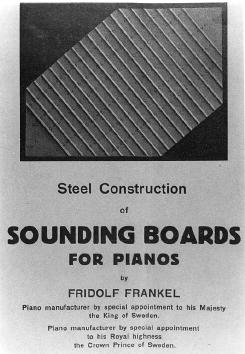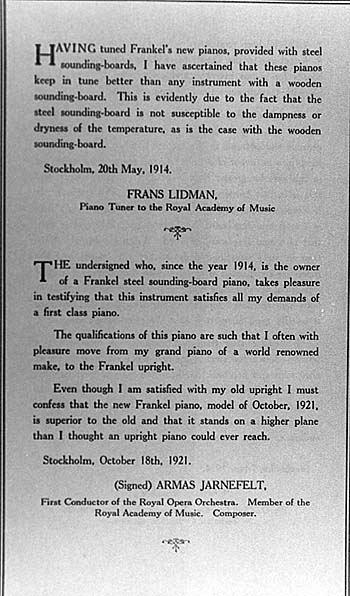 Fig. 23. Cover of Frankel booklet describing steel soundboard (1923).
Fig. 23. Cover of Frankel booklet describing steel soundboard (1923).

[<- Previous] [Contents of this lecture] [Next ->]
Why can't we use a material for soundboards that is not affected by humidity? Some early research on soundboard materials other than wood apparently was done here in Sweden by a man named Fridolf Frankel. Fig. 23 shows the cover of a booklet, written in English and dated 1923, describing a soundboard that is said to have been made of steel, 0.65 mm thick. I found the booklet in some old files of an American piano company. Despite the favoured testimonials for the performance of his pianos (Fig. 24), few instruments seem to have survived.
 Fig. 23. Cover of Frankel booklet describing steel soundboard (1923).
Fig. 23. Cover of Frankel booklet describing steel soundboard (1923).
 Fig. 24. Testimonials for Frankel's pianos.
Fig. 24. Testimonials for Frankel's pianos.
Many years later, in 1961, the American harpsichord builder, John Challis, constructed a piano having a metal soundboard and bridge (Challis 1963). Such an instrument was demonstrated by the pianist Arthur Loesser at a concert in New York City in 1967 (Henahan 1967). An excerpt from a recording of this concert can be heard in sound example 3. Apparently, the Challis piano was not suitable for playing a wide range of standard piano literature, for even at this concert it was used by the performer only for a few 18th century pieces.
In 1969, a U.S. patent was issued to P.A. Bert describing a soundboard for pianos employing sandwich construction with a cellular core and plastic facings. I have been told that at least one such instrument was built, but so far as I know, they were not marketed. I personally believe strongly that researchers today have available better materials for piano soundboards than ever before, and that only diligent applied research is needed in order to produce the next significant improvement in the piano.
When we try to "improve" the piano we must remember that we dare not change its essential character. If we do, it is almost certain to be rejected. Pianists who have spent years in learning to deal artfully with existing instruments quite naturally do not want to have to relearn their skills. They are incredibly sensitive to changes! I was present at one occasion on which an instrument of rather exotic construction was being tested. It looked like an ordinary piano and its sound was extremely pleasant, though slightly unusual. An excellent pianist was called in to give an opinion. He played at some length. To us in the audience the instrument sounded quite beautiful. Finally our pianist said it had a "nice sunny sound" and would be very good for Spanish piano music. After this encouraging initial response some minor changes were made and a rather more famous pianist was called in. This pianist reported that the instrument was good only for French piano music! Still further changes were made but this particular instrument never moved across the border and into Germany, musically speaking.
[<- Previous] [Top] [Contents of this lecture] [Next ->]
This lecture is one of Five lectures on the Acoustics of the piano
© 1990 Royal Swedish Academy of Music